Operating Systems Lecture Notes
26 March 2012 • Files
Outline
- Files, content and access.
- File implementation.
- Metadata
Files
- A file is a sequence of items.
- What kind of sequence?
- What kind of items?
- Files are named, external, independent, persistent, and potentially
gargantuan.
- External: files can exist outside a process's resource space.
- Independent: file lifetime is independent of associated processes' life times.
File Items
- At base, a file is a sequence of 2i bytes for small i.
- In Unix, i = 0.
- Bytes can be grouped into larger structures called records.
- Fixed-length records are all the same in a file.
- Variable-length records may vary in structure within a file.
Implementing Items
- Most operating systems implement byte-item files.
- Applications can turn byte-item files into more structured files.
- Databases, spread-sheets, HTML-XML files.
- Most operating systems also support record-based files in some form.
- Usually specialized, such as directories in Linux.
- Occasionally available as a service.
File Sequences
- The file sequence is indexed and variable length.
- Indexes are array-like, although occasionally content based.
- Usually only for record-based files.
- Sequence length changes easiest at the end (largest index).
- Size changes at other sequence locations are possible but expensive.
File Access
- Access patterns characterize the way items in a file are read or written.
- Sequential access: item by item in one direction.
- Direct (or random or indexed) access: jumping from item to item.
- Reliable access pattern preditions can be exploited to improve efficiency.
Files On Disk
- Many file properties (size, persistence) come from being implemented on disk.
- The file-disk mapping (file allocation) is similar to the
process-virtual-store mapping.
- Although the trade-offs are worked differently in each case.
- Efficiency is primary influence in resolving trade-offs.
- Efficient file use, as well as efficient disk use.
Allocation Structure
- File items are grouped into a file block.
- An item sequence is turned into a file-block sequence.
- A file block is a small multiple of the disk-block size.
- 2iK-bytes, 0 ≤ i ≤ 4.
- Whatever treats the disk most kindly.
- The juncture between adjacent file blocks can get awkward for record-based files.
File Blocks
- File blocks encourage efficient disk use.
- Amortize expensive disk operations over more data.
- Caches are lurking around someplace.
- But file blocks may waste disk space.

- This is internal fragmentation.
Contiguous Allocation
- Contiguous allocation is the simplest file-allocation policy.
- The whole file-block sequence is plopped into an available contiguous
disk-block sequence.
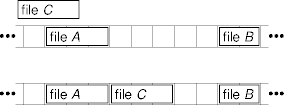
Contiguous Analysis
- Contiguously allocated files are not cheaply dynamic.
- Shrinking is easy but wasteful.
- Growing is limited and expensive.
- Good allocation requires maximum size declarations.
- Wasting space no matter how accurate the declarations.
- Over time, external fragmentation eats into allocatable space.
Linked-List Allocation
- Linked-list allocation is the antipodes to contiguous allocation.
- Allocate the file as a linked-list of file blocks.
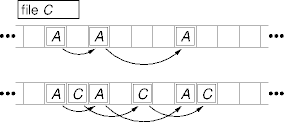
Linked-List Analysis
- Link-allocated files are dynamic at the ends.
- No external fragmentation.
- No arduous maximum-size estimates required.
- On the other hand:
- File traversal is more complex to implement.
- File transfer efficiency can easily plummet.
Link Information
- Where are the links in a linked-list allocation?
- They can be part of the file block.
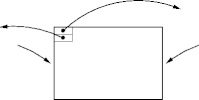
- In-block links introduces a host of irksome special cases.
- File traversal is performance hostile.
External Links
- Separate concerns: use file-blocks for data and other blocks for
links.
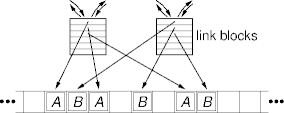
- File navigation is now buffer friendly.
Big Files
- External links still incur travel costs linear in file size.
- An N-way tree has sub-linear traversal costs.
- N is usually the file- (or disk-) block size divided by pointer size (4 to 8 bytes).
- Moving sequentially from file-block to file-block (leaf to leaf) in a tree is not simple.
- A node points to a file block (a leaf) or another tree node (an indirection block).
Access Trees
- Access trees can be tilted to put file blocks closer to the root on
one side.
- Small files have file blocks one hop away from the root.
- As the file grows, new file blocks move further down the tree.
- Three hops away is the usual stopping point.
Access Tree Illustrated
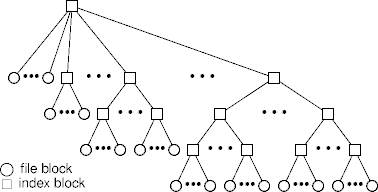
B+ Access Trees
- B+ trees are an alternative access tree.
- All pages are the same distance away from the root.
- B+ trees are self balancing to maintain uniform distance.
Hybrid Allocation
- Sequential allocation is inflexible but disk friendly.
- Linked-list allocation is flexible but disk hostile.
- How to combine sequential efficiency with linked-list flexibility?
- Allocate file-block runs for efficiency and link them for flexibility.
- Extent-based allocation.
Metadata
- External link blocks are an example of file metadata: data
about files.
- Link blocks are the first of many instances of file metadata.
- Metadata is packed along with the file, but usually not in the file.
- Metadata is a good place to keep statistics about file use to support adaptive performance adjustments.
File Protection
- File protection information is common metadata.
- Basic protections are read-only, write-only and execute-only.
- Execute-only implies read-only, most times.
- There are elaborate variations on the basic protections.
- But these require more metadata and higher-level structures.
Summary
- Files are persistent, large item sequences.
- Tree-based extent file implementations strike a balance between flexible file manipulation and efficient disk use.
- Metadata is data about files.
| This page last modified on 2012 March 26. |
